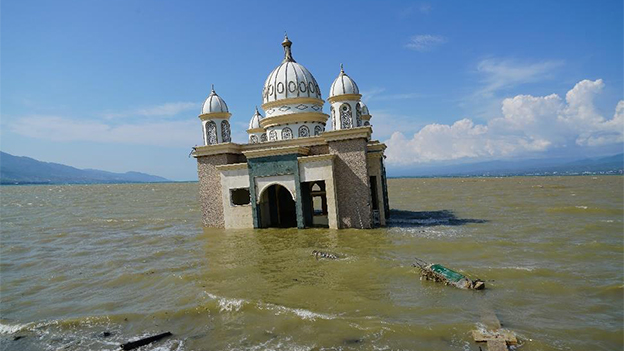INSUBCONTINENT EXCLUSIVE:
Image copyrightGeorgia Institute of TechnologyImage caption
The tsunami came ashore within three minutes of the quake
Scientists are getting closer to understanding the tsunami that struck Palu in Indonesia in September
Damaging waves rushed ashore after a Magnitude 7.8 quake, but researchers said at the time that they were surprised by their size
Now, a survey in the bay in front of the Sulawesi city shows significant subsidence of the seabed
This likely contributed to the abrupt displacement of water that then crashed on to land
More than 2,000 people lost their lives in the disaster
Preliminary results of various investigations are being reported here at the Fall Meeting of the American Geophysical Union - the largest
annual gathering of Earth and space scientists
The quake occurred on what is called a strike-slip fault, where the ground on one side of a rupture moves horizontally past the ground on
It is not a configuration normally associated with very large tsunamis
Nevertheless, this is what happened in the early evening of 28 September, around prayer time
Two main surges of water were observed, the second being the biggest and pushing up to 400m inland
Udrekh Al Hanif, from the Indonesian Agency for Assessment and Application of Technology (BPPT) in Jakarta, told the meeting that the
generation source of the tsunami had to be very close to the city because of the short interval between the onset of the quake and the
arrival of the high water - less than three minutes
Image copyrightBPPTImage caption
Scientists have sought answers on the bay floor
He and colleagues have
sought answers in a depth (bathymetric) map of the long, narrow inlet that leads to Palu at its head
The team is still working through the results, but the data indicates the seafloor in much of the bay dropped down in the quake
This, combined with a sharp movement of the crust northwards, could certainly have produced a tsunami, the Indonesian scientist said
"When we overlap the bathymetric data from before and after, we can see that almost all of the area of the seafloor inside the bay subsides
And from this data, we can also observe [the movement] to the north
So, actually, we have a vertical and a horizontal displacement," Udrekh Al Hanif told TheIndianSubcontinent News
Image copyrightBPPTImage caption
Looking south down the bay towards Palu: The seafloor dropped in response to the quake
Whether this behaviour was enough on its own to explain the tsunami's size is still open to question
There is evidence of several underwater landslides in the data
These, too, could have been a factor
Another possibility is an upwards thrust of the seabed in a zone some distance from Palu where the strike-slip fault splits into diverging
Image:Dramatic video shows buildings being knocked downMovement on both tracks at the same time might have compressed the crust in between
"This was a very unusual event but the tectonics tell us it could happen again," said Finn Løvholt from the Norwegian Geotechnical
"Indeed, this is not the first time an event has happened in Palu
It's probably the third or fourth event that has caused many fatalities
We had events in the 1960s and 1920s." Image copyrightGeorgia Institute of TechnologyImage caption
Damage has been
scanned with lidar to better understand the movement of the water
And this history is evidenced in the local culture where
there are specific words to describe features of a tsunami and a quake
In the September event, Palu witnessed a lot of liquefaction, where the structure of soils in the city was seen to collapse, to become
fluidised and flow even on very low gradients
Houses were consumed in the mud
Local people call this "Nalodo", which means something like "buried in black"
Hermann Fritz, from the Georgia Institute of Technology in the US, said Palu demonstrated the challenge confronting the local population
"This tsunami arrived very fast, within minutes," he stressed
"That basically leaves no time for warnings
That's very different from Japan (in 2011) where there was an eternity of time - more than 30 minutes everywhere until the first person was
That's the challenge for these local tsunamis: people have to self-evacuate." Widjo Kongko, also from the BPPT, spoke of some complacency
following an emergency drill conducted in Palu in 2012
"It said go to high ground within 5-10 minutes
The people need to learn that the tsunami can come much, much quicker." Jonathan.Amos-INTERNET@TheIndianSubcontinent.co.uk and follow me
on Twitter: @TheIndianSubcontinentAmos

